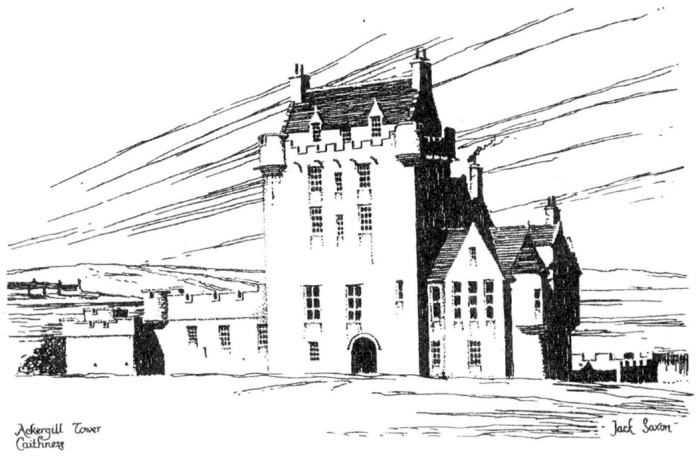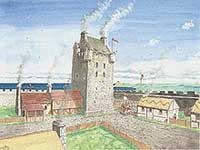|
The History of Ackergill Tower The Cheyne and the Keiths There is evidence that the Tower was completed well before its neighbour Castle Gimigoe, which is known to have been completed in 1494. The earliest known written recording of Ackergill was made in 1538 when it was mentioned in a legal instrument of the period. There appears to be little doubt that a castle or fortification of some kind existed on the site prior to the fifteenth century. Indeed it is from this early period that the famous story of Helen Gunn dates. Known as the 'Beauty of Braemore', she was abducted from her home in Braemore on her wedding night and kept prisoner in the Tower by the infamous Dugald Keith. Rather than succumb to his less than honourable advances, she leapt from the battlements. The stone on which she was believed to have fallen and which bears her outline can be seen nearby. Her ghost - 'The Green Lady', is thought to be seen from time to time on the battlements. The male line of the Cheyne family, the earliest known owners of Ackergill Tower, expired in 1350. The eldest daughter, Mariota, married John de Keith, second son of Sir Edward Keith. And so the lands of Ackergill passed into the hands of the Great Earl Marishal of Scotland. It is clear that the Keiths of Inverugie and Ackergill spent little of their time in Caithness. Confusion exists because records show many Keith signatures on documents pertaining to Ackergill. But the ancient Tower was administered by Captains who were authorised by their laird to sign Keith. The lands of Ackergill and Inverugie passed in direct descent from John and Mariota for eight generations until the Battle of Flodden in 1513. Sir William Keith of Ackergill fell at Flodden along with the two elder sons of his chief, the Earl Marshall. The heiress married the heir to the Earl Marshall so the large possessions of both branches were combined. At this time the Keiths were at the zenith of their power, prestige and wealth. It is said of George, heir of the union of the two branches and fifth Earl Marshall, that he could travel from Berwick to Ackergill without ever requiring to take a meal or a nights rest other than in his own house. These were barbarous times and it became increasingly difficult for the Earl Marshals to maintain their remote lands in the far north. In 1547, Queen Mary granted a remission to George, Earl of Caithness, from treasonably taking and holding the castle and for keeping the Captain Alexander Keith a prisoner in Castle Girnigoe. Then in 1592 a complaint was made to the privy council by George Earl Marshal that his brother Robert Keith had taken his house at Ackergill. The result was that Keith was pronounced a rebel. In 1598 the Earl complained again to the Lords, this time that John Keith of Sibster and his two sons had 'ledderit the walls of Ackergill' by night and had entered and spoiled the castle, wounded his servants 'now keeps the place'. The Earls of Caithness The wicked fifth Earl was succeeded by his great grandson George, who built himself a new castle at Thurso East. (This itself is now a ruin but the current Viscount Thurso still lives close to the grounds of the old fortress). Ackergill was neglected, partly because of its proximity to Girnigoe Castle whose ruins lie close-by to the lighthouse at Noss Head, and partly because the Earl was suffering from severe financial embarrassment. He certainly complained that during the civil war his castles had been occupied and damaged by the military and that he had received no compensation. Cromwell's troops were garrisoned in the Tower in 1671 and a letter written in the castle from one of the troopers still exists. Earl George became indebted to Campbell of Glenorchy who forced him in lieu of payment to leave him his titles and estates. On the death of the Earl in 1676 there was a struggle between Glenorchy and the rightful heir. Finally, the estates were retained by Glenorchy but the title was restored. However, the militant people of Caithness made the administration of the estates so impossible for Glenorchy that in 1699 it was sold to William Dunbar, Baronet, of Hempriggs. After a break of eighty seven years a descendant of Sir Reginald de Cheyne once again owned the Tower. The Dunbars Eventually, James 1 in 1435, thinking the family had got too powerful, forfeited their Earldom from George the eleventh Earl. The family then moved to Morayshire where they acquired that Earldom by marriage with an heiress of the Randolphs. But it too passed from them after being held by two heiresses. In 1691 Sir William Dunbar purchased Teistane three miles south of Wick. He built a mansion there and renamed it Hempriggs after their original estate in Morayshire. With acquisition of Ackergill Tower in 1699 the branch of the ancient family of Dunbar became the largest landowner in Caithness. Sir William Dunbar was created the first Baronet of Hempriggs in 1700 with the remainder restricted to heirs male, but as he only had one daughter, Elizabeth, he later executed an entail of his lands in her favour, and asked Queen Anne for a new baronetcy for Elizabeth's second husband, the Honourable James Sutherland. On Sir William's death his baronetcy passed on to his brother Robert and still exists, although now known as Northfield, while his son in law was created Sir James Sutherland Dunbar of Hempriggs. It seems that during the Lairdship of Sir James's son, William, renovations were carried out at the Tower. Part of an East wing can be seen on the Daniel Etching, a copy of which hangs in the Tower. A writer in 1726 said that Ackergill Tower was then 'a strong Tower and yet in repair and betwixt it and the sea is a good new house lately built'. Bishop Forbes visited the Tower in 1762 and mentioned the vaulted chamber on the ground floor was then 'used as a kitchen and that Sir William had cut out some large windows and was building up the Tower in a pretty and elegant way'. It is possible that during these renovations that the ancient caphouse and battlements were removed and a flat roof substituted. James Sutherland, First Baronet of Hempriggs, was also the second son of Lord Duffus. Thus, when his elder brother's direct male line died out in 1827, his own descendants inherited the Duffus title, Duffus estates having been forfeited in the Jacobite rebellion of 1715, Sir Benjamin Dunbar, grandson of James Sutherland, became the sixth Baron. There is a story still well known in the county that when Benjamin, Lord Duffus, married Janet Mackay in 1785 they spent their wedding night in a humble thatched cottage as, when en route to Hempriggs House for their honeymoon, they found the Wick river in spate and impassable. Lord Duffus died in 1845 and was succeeded by his elder son Sir George Sutherland Dunbar, fourth baronet, who never used the title of Lord Duffus. It was Sir George who carried out the great improvements in the estate. He carried out great farming improvements to his lands and the model farm built at Ackergill Mains was renowned throughout Scotland. But his main achievement was at Ackergill Tower where he used the ubiquitous and eminent Edinburgh architect, David Bryce, to transform the castle into the finest gentleman's seat in the north of Scotland. The medieval tower was modernised and the caphouse restored. A new wing in the distinctive Bryce style was added. The house was refurbished. The great double vaulted dining hall was redecorated with Sir George's coat of arms in gold leaf The pipers gallery was infilled with fine lead glass. In the bedrooms the wall coverings were of the first wallpapers to reach Scotland. Sir George died in 1876 and was succeeded by his nephew Benjamin who had become a recluse before he inherited the title and would have nothing to do with the estate or the baronetcy. The estates were managed by his son, Garden, who took the name Duff-Dunbar on his marriage to Louise Duff from Hatton Castle. Garden predeceased his father leaving two young sons. George, the eldest, Sir George Duff-Sutherland-Dunbar sixth baronet, and Kenneth who fell in the First Great War and whose only son Kenneth fell in the second Great War. Louisa Duff-Dunbar, widowed by the death of Garden, looked after the estate and built an interesting collection of fossils and beetles, some of which remain in the Tower to this day. Her eldest son Sir George succeeded as Sixth Baronet on his grandfather's death in 1898. He spent little of his time at Ackergill having joined the civil service and serving most of his life in India. He became something of a scholar on Indian history and some of his manuscripts can be found in the castle. On his death he was succeeded by his only son Sir George Cospatrick Sutherland Duff-Dunbar, who as a barrister, spent most of his life in London. He died unmarried in 1966. A distant cousin Mrs Maureen Blake inherited the estate and title following a long and debilitating family dispute eventually resolved in her favour by the Lord Lyon. The effect of this was to render the estate exceedingly short of funds. The castle was lived in for short periods during the summer and soon fell into serious disrepair. The estates from 1890 to 1986 had already declined from over 100,000 acres to less than 4000. The income generated from small farms rented to tenant farmers did little to support the cost of an ageing and demanding building. The castle was considered to be beyond salvation when in 1986 the Trustees of the estate put Ackergill Tower up for sale. It was bought by John and Arlette Banister; only the fourth owner in the Tower's long and chequered history. A two and a half year programme of restoration took place starting in the autumn of 1987. Under the Povail Worthington Partnership from Edinburgh and Robert Galbraith, the castle was meticulously restored to its former glory. The fabric of the building was repaired and the original contents cleaned and rejuvenated. Central heating, electricity and new services installed. In September 1988, the castle re-opened its doors as the great house that it truly is. Ackergill Tower - the magnificent and ancient castle on the very edge of the sea - has gained a reputation as one of the world's most exclusive retreats for corporate meetings and entertainment or private house parties. It is primarily a home with 25 luxurious bedrooms and five star service to match. The local seasonal produce from the garden and estate, locally fished scallops and lobster, the tenderest Caithness lamb and the northern famous beef, make the kitchen an exceptional experience. An opera house for music recitals, and estate for sport, fishing and a wealth of local activities, pipe band music etc. are there to entertain, and for enjoyment. Wildlife and birds on both the sea and moor make Caithness a naturalists paradise. Welcome! See Also
|

